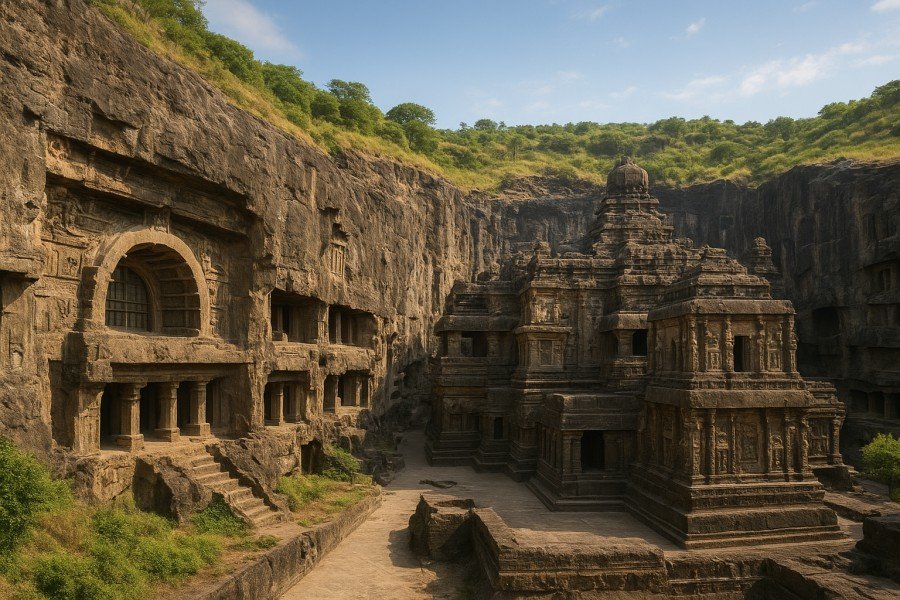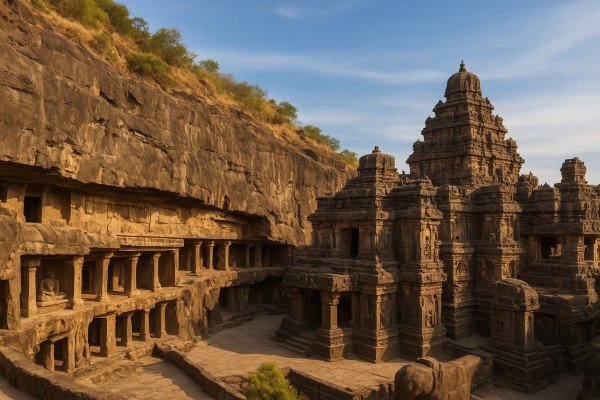The Ellora and Ajanta Caves stand as two of the most breathtaking heritage sites in India, blending history, culture, art, and spirituality into one timeless marvel. These ancient rock-cut caves, located in Maharashtra, have captured the imagination of travelers, historians, and art lovers from across the world. Recognized as UNESCO World Heritage Sites, both Ajanta and Ellora showcase the architectural brilliance of early civilizations and their devotion to religion, storytelling, and craftsmanship.
Historical Background of Ajanta Caves
The Ajanta Caves date back as early as the 2nd century BCE and are among the finest surviving examples of ancient Buddhist art. Carved into a horseshoe-shaped cliff along the Waghora River, the caves once served as monastic retreats for Buddhist monks. Their interiors are adorned with vibrant murals, delicate sculptures, and intricate carvings that narrate the life of the Buddha and the Jataka tales.
The murals are particularly significant because they are some of the earliest surviving paintings in India, depicting scenes of devotion, compassion, and everyday life with astonishing detail. What makes Ajanta remarkable is not only the scale of the carvings but also the way they reflect the religious and cultural harmony of that period.
The Grandeur of Ellora Caves
Located around 100 kilometers from Ajanta, the Ellora Caves present a stunning contrast. Unlike Ajanta, Ellora is not exclusively Buddhist. It reflects a confluence of three religions – Hinduism, Buddhism, and Jainism. Constructed between the 6th and 10th centuries CE, Ellora consists of 34 rock-cut caves, each an architectural wonder in its own right.
The highlight of Ellora is undoubtedly the Kailasa Temple (Cave 16). Carved from a single rock, it is one of the largest monolithic structures in the world. The temple is dedicated to Lord Shiva and displays awe-inspiring carvings of deities, mythological stories, and celestial beings. Ellora’s caves embody the message of tolerance and inclusivity, representing the spirit of India’s pluralism long before it became a modern idea.

Mysteries Surrounding the Caves
While historians have documented much about the origins of Ajanta and Ellora, several mysteries remain unsolved. One question often raised is how ancient artisans managed such precise carvings with the limited tools available during their time. Another intriguing mystery lies in the alignment and placement of the caves, which suggest a remarkable understanding of geology, engineering, and even astronomy.
The Kailasa Temple, in particular, continues to baffle researchers. Scholars believe it would have taken thousands of workers and decades of labor to carve the structure, yet its symmetry and precision are near flawless. These mysteries add to the allure of the caves, inviting visitors and scholars to explore further.
Cultural and Artistic Significance
Beyond their historical importance, the Ajanta and Ellora Caves remain living testimonies of India’s rich cultural and artistic legacy. Ajanta’s paintings capture emotions and human expressions with unmatched skill, while Ellora’s carvings showcase a boldness and scale that is rarely seen in ancient architecture.
For artists, historians, and spiritual seekers, these caves are more than monuments; they are classrooms of creativity and devotion. They highlight how art was used not only as a form of worship but also as a medium to tell stories, share wisdom, and connect communities.
Tourism and Modern-Day Relevance
Today, the Ellora and Ajanta Caves attract millions of tourists each year. The sites are well-maintained and continue to inspire awe in both domestic and international visitors. Tourism boards encourage travelers to explore these caves not just for their grandeur but also to understand India’s spiritual and cultural roots.
The caves are also vital for educational and research purposes, providing scholars insights into the evolution of Indian art and architecture. They remain essential stops for those seeking to explore heritage tourism in India, alongside landmarks like the Taj Mahal and Khajuraho temples.
Conclusion
The Ellora and Ajanta Caves are not merely stone structures; they are living chronicles of India’s history, artistry, and spirituality. Their grandeur reflects the determination of ancient civilizations to create something that would endure beyond their own lifetimes. As you walk through the halls of Ajanta or gaze up at the towering Kailasa Temple at Ellora, you realize these monuments are reminders of what humanity can achieve with vision, devotion, and artistry.
For anyone passionate about history or eager to witness the world’s greatest heritage sites, the Ellora and Ajanta Caves remain destinations that must not be missed.








